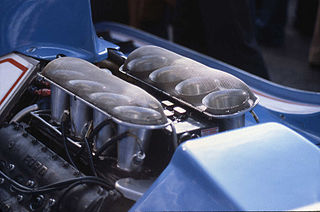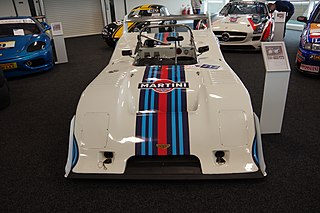
Cosworth is a British automotive engineering company founded in London in 1958, specialising in high-performance internal combustion engines, powertrain, and electronics for automobile racing (motorsport) and mainstream automotive industries. Cosworth is based in Northampton, England, with facilities in Cottenham, England, Silverstone, England, and Indianapolis, IN, US.

Formula Two is a type of open-wheel formula racing category first codified in 1948. It was replaced in 1985 by Formula 3000, but revived by the FIA from 2009–2012 in the form of the FIA Formula Two Championship. The name returned in 2017 when the former GP2 Series became known as the FIA Formula 2 Championship.

The DFV is an internal combustion engine that was originally produced by Cosworth for Formula One motor racing. The name is an abbreviation of Double Four Valve, the engine being a V8 development of the earlier four-cylinder FVA, which had four valves per cylinder.

Formula 5000 was an open wheel, single seater auto-racing formula that ran in different series in various regions around the world from 1968 to 1982. It was originally intended as a low-cost series aimed at open-wheel racing cars that no longer fit into any particular formula. The '5000' denomination comes from the maximum 5.0 litre engine capacity allowed in the cars, although many cars ran with smaller engines. Manufacturers included McLaren, Eagle, March, Lola, Lotus, Elfin, Matich and Chevron.

The Mirage Lightweight Racing Car was a family of race cars built by J.W. Automotive Engineereing (JWAE) at Slough in England, initially to compete in international sports car races in the colours of the Gulf Oil Corporation.

The McLaren M23 was a Formula One racing car designed by Gordon Coppuck, with input from John Barnard, and built by the McLaren team. It was a development of the McLaren M16 Indianapolis 500 car. A Ford Cosworth DFV engine was used, which was prepared by specialist tuning company Nicholson-McLaren Engines. This helped push the DFV's horsepower output to around 490 bhp.
The 1973 World Sportscar Championship season was the 21st season of FIA World Sportscar Championship motor racing. It featured the 1973 World Championship for Makes and the 1973 Cup for GT Cars which were contested concurrently over a ten race series. The World Championship for Makes, which was open to Group 5 Sports Cars and Group 4 GT Cars, was won by Matra and the Cup for GT Cars, which was open only to Group 4 GT Cars, was won by Porsche.

The Tyrrell 012 is a Formula One racing car that was designed by Maurice Philippe for the Tyrrell team. It was introduced for the 1983 season, and was subsequently used in 1984 and the first few races of 1985.

The Lola T290, and its evolutions, the T292, T294, T296, T297, T298, and T299, are a series of Group 5 Sports 2000 prototype race cars, designed and developed by Bob Marston, John Barnard, Patrick Head, and Eric Broadley, and built by British manufacturer and constructor Lola, for European 2-Litre Championship sports car racing series, between 1972 and 1981.

The Chevron B21 is a 2-liter Group 5 sports prototype race car, designed, developed and built by British manufacturer Chevron, in 1972. Over its racing career, spanning 13 years, it won a total of 23 races, scored 45 podium finishes, and clinched 11 pole positions. It was powered by a naturally-aspirated 2.0 L (120 cu in) Ford-Cosworth BDG, or BMW M12/7, four-cylinder engine, both making around 275 hp (205 kW). Only 28 cars were built.

The Chevron B31 was a sports prototype racing car built by Chevron Cars Ltd in 1975, and initially used in the European 2-Litre Championship. The car was an evolution of the Chevron B26, and was initially fitted with a 2-litre Hart 420R straight-four engine producing 290 hp. However, various other engines were used; the car also ran with engines such as the 3-litre Cosworth DFV V8, the 2-litre Cosworth FVD/Cosworth BDG straight-four engines, and the 2-litre BMW M12 straight-four, amongst others.
Ian Grob is a former English racing driver. He raced in a number of events, including European Formula 2 and Le Mans 24 Hours. He retired from international motor sport after his last race, 1980 24 Hours of Daytona.

The Ligier JS3 is a sports-racing car that was built by Automobiles Ligier. It was unveiled in 1971 and ended its competition life in the same year. Only one JS3, chassis JS3-01, was ever built.

The Ford-Cosworth Indy V8 engine is a series of mechanically similar, turbocharged, 2.65-liter, Indy car racing V-8 engines, designed and developed by Cosworth in partnership with Ford. It was produced for over 30 years. It was used in U.S.A.C. Championship Car, C.A.R.T., and later Champ Car World Series; between 1976 and 2007. The DFX engine was the Indy car version of the highly successful 3-liter Cosworth DFV Formula One engine developed by former Lotus engineer Keith Duckworth and Colin Chapman, with financial backing from Ford for the Lotus 49 to campaign the 1967 season. This engine had 155 wins between 1967 and 1985 in F1. The DFX variant was initially developed for Indy car use by Parnelli Jones in 1976, with Cosworth soon taking over. This engine won the Indianapolis 500 ten consecutive years from 1978 to 1987, as well as winning all USAC and CART championships between 1977 and 1987. It powered 81 consecutive Indy car victories from 1981 to 1986, with 153 Indy car victories total.

The Chevron B24 was a Formula 5000 racing car developed by Chevron Cars in 1972.
The McLaren M25 was an open-wheel racing car, designed by John Barnard, and developed and built by British constructor McLaren in 1973. It was based on the successful McLaren M23 Formula One car. It was originally built with the intention to be a Formula 5000 car, but it did not compete in any F5000 races, and didn't even contest in a motor race until 1976, which by that, was too late, since Formula 5000 racing had folded. It then became a Formula One car for Emilio de Villota, and was equipped with a 3.0 L (180 cu in) Ford-Cosworth DFV V8 engine, where it only entered one World Championship Grand Prix, the 1978 Spanish Grand Prix. de Villota damaged the car in an accident during the practice session for the race, so the team reverted his car back to the M23.

The Chevron B16 was a Group 4 sports prototype race car, designed, developed, and built in 1969 by the British racing car manufacturer Chevron Cars as a two-seater racing sports car for the makes world championship. Brian Redman won the very first outing, the 500 km (310 mi) race at the Nürburgring on September 7, 1969, at a time of 3:13:01.6 hours. The last victory with a Chevron B16 was achieved by Clemens Schickentanz on July 11, 1971, in the sports car race at the Norisring.

The Chevron B19 is a 2-liter sports prototype race car, designed, developed and built by British manufacturer Chevron in 1971. Only 35 cars were built.

The Lola T210, and its evolution, the Lola T212, are Group 6 sports prototype race cars, designed, developed and built by British manufacturer Lola, for the newly created European 2-Litre sports car racing championship, in 1970.

The Lola T280, and its evolutions, the Lola T282, Lola T284, and Lola T286, are a series of 3-liter Group 5 sports prototype race cars, designed by Eric Broadley, John Barnard, and Patrick Head, and developed and built by British manufacturer and constructor Lola, for World Sportscar Championship sports car racing, between 1972 and 1976.

















